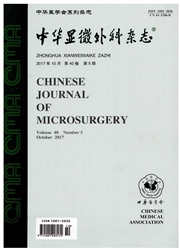

 中文摘要:
中文摘要:
目的探讨应用正常供体神经修复预变性受体神经时,再生神经纤维放大的效果。方法将雄性SD大鼠12只,随机分为变性组、对照组,所有动物均实行手术。变性组应用部分正常腓总神经修复变性8周胫神经远端;对照组应用部分正常腓总神经修复UPN损伤后胫神经远端。术后3个月进行神经电生理测量、肌力测量、组织学观察、神经锇酸染色及有髓神经纤维计数,并计算两组神经再生放大率。结果变性组和对照组神经传导速度分别为(16.992±3.737)m/s和(23.092±2.788)m/s;肌肉强直收缩力恢复率为(39.642±5.865)%和(71.098±6.778)%;再生有髓神经纤维数分别为1718.2±282.0和3340.0±506.5;神经再生放大率1.581±0.329和3.098±0.642;以上指标变性组均低于对照组(P〈0.05)。结论应用正常神经修复8周变性神经远端时,神经纤维再生放大率降低,说明损伤远端神经较长时间变性。接受再生神经纤维长入的能力降低。
 英文摘要:
英文摘要:
Objective To investigate the amplifying results of repairing degenerated distal receptor nerves with normal proximal donor nerves. Methods The study was carried out on 12 adult male SD rats that randomly derided into degeneration group and control group. The distal tibial nerve stumps as receptor nerve were denervated for 8 weeks before cross-sutured with partial freshly transected proximal common peroneal nerve stumps in the degeneration group, while in the control group, freshly transected distal tibial nerve stumps were sutured with partial freshly cut proximal common peroneal nerve stumps. The motor nerve conduction (MCV), muscle rigidity contraction force were measured,the histological examinations were car- ded out and the numbers of myelinated axons were calculated 3 months after the operation. Results The degeneration group showed a poorer regeneration capacity than the control group (P 〈 0.05). The MCV were (16.992 ± 3.737) m/s, (23.092 ± 2.788) m/s respectively; The ratio of muscle force were (39.642 ± 5.865)% and (71.098 ± 6.778)% respectively. The regenerated myelinated nerve fiber number were 1718.2 ± 282.0 and 3340.0 ± 506.5 respectively in degeneration group and control group. The amplifying ratio of the degeneration group and control group were 1.581±0.329 and 3.098±0.642. Conclusion The amplifying results of repairing the degenerated nerves are poorer than repairing the freshly injury distal nerves with the freshly transected proximal donor nerves, the results demonstrate a progressive inability of chronically degeneration of the distal nerve to support axonal regeneration.
 同期刊论文项目
同期刊论文项目
 同项目期刊论文
同项目期刊论文
 The Electrophysiology Analysis of Biological Conduit Sleeve Bridging Rhesus Monkey Median Nerve Inju
The Electrophysiology Analysis of Biological Conduit Sleeve Bridging Rhesus Monkey Median Nerve Inju The Influence of Brain Injury or Peripheral Nerve Injury on Calcitonin Gene-Related Peptide Concentr
The Influence of Brain Injury or Peripheral Nerve Injury on Calcitonin Gene-Related Peptide Concentr Effects of Hedysari Polysaccharides on Regeneration and Function Recovery Following Peripheral Nerve
Effects of Hedysari Polysaccharides on Regeneration and Function Recovery Following Peripheral Nerve Maximum number of collaterals developed by one axon during peripheral nerve regeneration and the inf
Maximum number of collaterals developed by one axon during peripheral nerve regeneration and the inf 期刊信息
期刊信息
